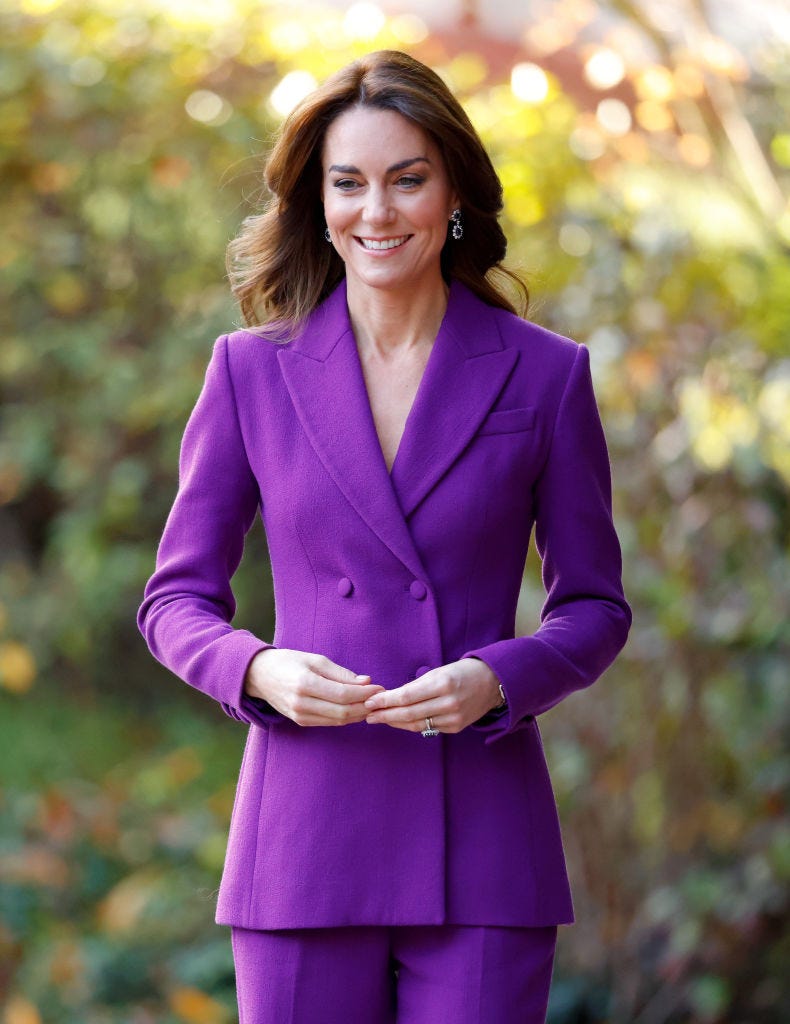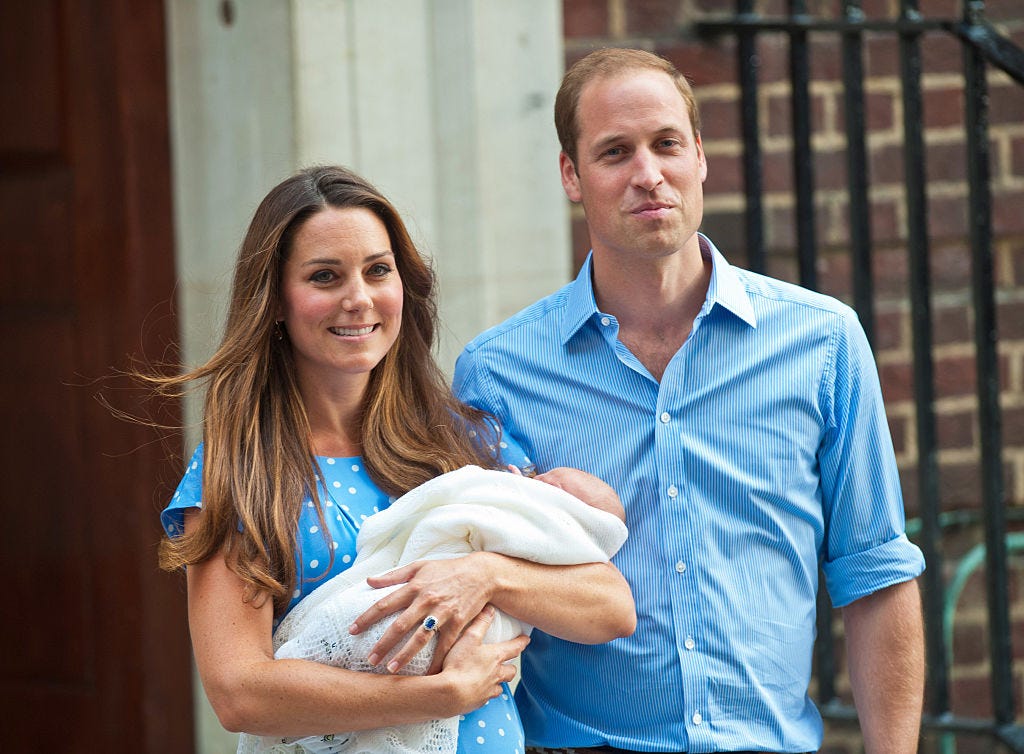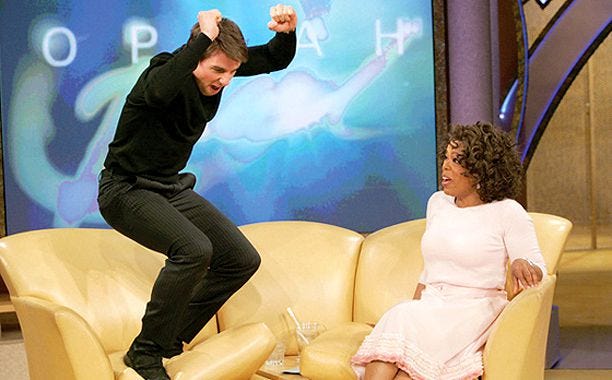If you open this newsletter all the time, if you forward to your friends and co-workers, if it challenges you think in new and different ways — consider subscribing.
You’ll get access to the weekly Things I Read and Loved at the end of the Sunday newsletter, the massive links/recs posts, the ability to comment, and the knowledge that you’re paying for the stuff that adds value to your life. Plus, there’s the threads: like Friday’s TikTok Best Practices, which is at once philosophical AND practical (how to avoid shopping prompts, for example) and Tuesday’s What Are You *Not* Buying (On the Internet) which went in many, MANY unexpected (but useful!) directions.
Earlier this week, in a short piece for the New York Times, Jessica Grose asked: Must a princess’s body be a public commodity?
The answer, at least on the surface, is no. We have no right to intimate knowledge of the health of a princess or, for that matter, any celebrity. And dozens of celebrities have demonstrated that you can recede from public view, give birth to a secret baby, go through treatment, or receive treatment for a serious illness — without inspiring interlocking conspiracy theories.
So why can’t the Princess of Wales, better known as Kate Middleton, convalesce in peace following “planned abdominal surgery”? Why is it so difficult to believe that there is nothing nefarious about disappearing from public view (for a week, for several months) to attend to one’s health? What makes knowledge of her health and location feel like a public right?
The answer is pretty straightforward: the powers that control the images of the royal family have a long-standing investment in the royals as commodities. The royals are sovereign individuals, at least theoretically — but they are also symbols of the health and future of the monarchy. When the Princess appeared in a dress with a blow-out after giving birth to her first son — the eventual heir to the throne — she was underlining the robust future of the line. (When she appeared in heels and a blowout just seven hours after giving birth to her third child in 2018, it felt like she was proving something….else).
The consistency of the Princess’s appearance (the soft waves of never-changing hair, the makeup, the repeated modest silhouettes), particularly in the wake of the Duke and Duchess of Sussex’s retreat from royal duties and the death of Queen Elizabeth, reassert as much. In public and “private” family photos, in bland public statements, in measured public appearances, Catherine is the pillar: a beacon of contemporary yet undoubtedly proper British femininity and motherhood. Whatever spark you may have seen in her eyes when she and Prince William first started dating has dulled into the soft gaze of power, of poise, of expectations fulfilled — and of repetition. Smize, wave, walk upright without faltering, repeat.
Princess Catherine has a keen understanding of her role as the blandly beautiful distraction from larger questions of the monarchy’s existence and legitimacy. Her posture towards that role has been accentuated in contrast to that of Meghan Markle, aka the Duchess of Sussex. To some, Markle is the one who helped Prince Harry see the abuse and neglect he endured; to others, she is an ungrateful, conniving troublemaker. With both her speech and very existence as a bi-racial woman, Markle detracts and destabilizes — questioning the white supremacy and at the imperial heart of the monarchy.

But not Princess Catherine. She steps up, repeats. She puts on her panty-hose and pumps and tasteful rainbow of pantsuits and plays the game. Whatever her misgivings or ambivalence, we have no clue of it. For those who’d argue that she has no other choice: of course she does. The history of the royal family — in both the U.K. and elsewhere — is replete with examples of monarchs who’ve chosen otherwise, and not just in the recent past. There are models of dissent. Again: there was often one, if not more, in the same royal rooms as her. She and Prince William have chosen a different route. It’s no longer stable, but it is familiar. And it requires an understanding of the self, again, as symbol — as a part of the public and funded by it.
The institution of the monarchy has negotiated privacy and discretion in the past. King Charles had a years-long affair with now-Queen Camilla while he was still married to Princess Diana, just to start. But the institution also does what publicists for all manner of powerful people do: offer access in exchange for following their rules, particularly when it comes to publishing “unsanctioned” photos.
For a run-down of how access has historically worked, you can go deep with Ellie Hall over at Nieman Lab. What’s striking — at least from a history-of-celebrity-gossip perspective — is how the institution has managed to maintain this level of control amidst massive turmoil in the gossip industry coinciding with the rise of digital tech. Digital photos, sure, but also utterly unsanctioned (and largely uncontrollable) gossip blogs and Twitter accounts wresting control of celebrity images and their meaning.
But not for the British royalty — and you can only attribute so much to the difference in libel laws between the US and the UK. There were scandalous ruptures (see especially: Prince Harry in the Nazi costume in 2005) but the sheer spectacle of two princely romances (one for William, a handful for Harry) culminating in two weddings (and eventual pregnancies/babies) plus a bunch of implicit and explicit guilt-tripping about the role of the paparazzi in Princess Diana’s death meant that the core of the agreement remained intact. You can gossip, but you must gossip on our terms, with our images, riffing on our talking points.
For nearly two decades, the meaning of the British royals remained relatively stable — even with very real change within their ranks and in the technologies that mediated that world for public consumption. But over the last few years, three things destabilized that meaning:
1.) The Death of Queen Elizabeth in September 2022
In hindsight, it’s easy to attribute much of the monarchy’s modern resilience to the sheer longevity of the Queen. Her image withstood and recovered from the destabilization of Charles and Diana’s divorce in 1996. Even though public sympathy largely shifted towards Diana in the wake of both the divorce and her death, that sympathy extended to Diana’s children — who were still very much affixed to the lineage of the Queen. The slightly bent, graying monarch came off as relatively heartless but very much a product of her time: calm and carrying on, enduring the fall of empire.
The Queen’s death, at age 96, offered oxygen to long-simmering debates about the purpose and utility of the monarchy — and this time, with no romances or births to deflect or distract. The only real distraction was another destabilization, namely —
2.) Prince Harry’s Defection
Moving to the United States, stepping down from his role as a public royal, writing Spare, appearing on Oprah — I realize that public opinion varies significantly between the U.K. and elsewhere, but whatever you think of the Duke and Duchess, you can agree that their recounting of abuse, mistreatment, and racism made the entire royal enterprise seem, amongst other things, antiquated. Anachronistic. Unnecessary, indefensible, the worst of the bad old ways.
(It’s worth noting that those who’ve attempted to smear and otherwise discredit Harry and Meghan either have a vested interest in maintaining the monarchy’s current levels of power — or don’t want to believe that the symbol of their country is corrupt at its core, and are engaging in magical and complicated storytelling to avoid the thought).
3.) The Crown, et. al.
I don’t want to overestimate the effect of a six-season Netflix series. But at the same time: a lot of people severely underestimate the ideological power of a text like The Crown. The show is part fact, part elaboration, part only-slightly-bombastic fabrication — but what matters is that it’s a global phenomenon, watched by millions, with an underlying thesis that what you see of the royals, both now and historically, is just the tip of an elaborate iceberg.
Yes, people knew this. Or at least sort of knew this — it’s been the theme of countless books, gossip columns, and previous movies. But none have been as sweeping in scope, as consistent in message, as ubiquitous as The Crown — which became even more believable in part because it was not overtly hostile to the enterprise.
4.) The Decline of Press Authority, the Rise of AI, the End of “Shared Reality”
There have always been royal rumors and royal blind items and royal scandal-mongering in the tabloids — but the decline of press authority, the AI-facilitated understanding that seemingly “authentic” images can not only be manipulated but created out of whole cloth, and the plummeting trust in public institutions…..these forces collide and feed skepticism of any narrative released or touched by the monarchy. (For a smart take on this line of thinking, read more from my partner, Charlie Warzel, here)
That was the status quo in January 2024, when the royal apparatus acknowledged that the Princess was in recovery from “planned” abdominal surgery — a description so simultaneously vague and precise as to beg for more questions.
From there, the timeline got more complicated — check out Ellie Hall’s rendering of it at the bottom of the Nieman Lab article — but a few things stick out: 1) the public announcement of King Charles’s treatment for unspecified cancer (and his apparent insistence on remaining in relative public view); 2) TMZ’s (absolutely unsanctioned) publication of a photo of the Princess and her mother driving on March 4th (as in the US, TMZ gives no fucks about “understandings” between those in power and various publications seeking access) and the refusal of the UK press to run the image, giving credence to the idea that the UK press is more interested in toe-ing the palace line than the “truth”; 3) the sheer number of Middleton family members who can be tracked via social media (and whose vacations seemingly confirm that the Princess is not on death’s door) or are sought out (like the Princess’s Big Brother-starring uncle) for loose cannon comments.
Catherine is not the first “gravel-drive” middle-class commoner to marry into a title, and the monarchy has had to deal with loose cannons before. But gossip loves a vacuum, and this timeline is chocked full of them — enough to really get the this is all bullshit train moving. Once in motion, it began crashing through the already-weakened institution, using each flimsily constructed attempt at a public counter as fuel.
If the palace had decided to take its normal tact — which, as Lainey Gossip reminds us, is “never explain, never complain” — and the Princess had emerged into public view, as scheduled, at some point after Easter…..the rumors wouldn’t have died down, but the train would’ve gradually slowed.
Instead, they stoked the flames — and the train has absolutely run away. This past Sunday, on UK Mother’s Day, Kensington Palace releases an “official” portrait of the laughing Princess, seemingly in good health, and her three children with a photo credit listed for Prince William.
The conspiracy train immediately began scrutinizing the photo, picking up on several telltale signs of Photoshop and digital manipulation. The AP issued a (very rare) “kill notice” alerting organizations not to use the photo; other photo agencies quickly followed suit. On X, the palace (tweeting as “C”) “apologies” for the confusion caused by her “experiment” as an “amateur photographer.”
It’s just so hilariously poorly done, like PR-seminar-case-study-material poorly done — and, I’d argue, evidence that the royal PR apparatus does not understand the stakes or the field on which it is playing. It reminds me of Tom Cruise jumping on Oprah’s couch back in 2005, declaring his love for Katie Holmes after firing his longtime publicist, utterly oblivious to the way the clip would become central to the newly formed joke at the heart of his image.
Cruise was so sure of his understanding of the game, so bored with his tight-fisted but well-respected publicist telling him what he could and shouldn’t talk about, he couldn’t see a sea-change in gossip coming straight for him.
There was just so much hubris — which made it all the easier to lampoon him, to laugh readily with the suggestion that an alien had impregnated Holmes, to ridicule all the dirty dancing and the PDA. Today, Cruise is still working, still unfathomably rich, still powerful. But he’s never left that tinge of abjection behind.
A similar level of hubris is on display this week at Kensington. The Princess is almost certainly just….resting. She probably doesn’t feel like smizing, or having her hair done, or walking in heels. She doesn’t want to be a symbol for awhile. That’s deeply relatable content. But a PR apparatus that only knows how speak in unequivocal and broad statements doesn’t know how to leverage that reality — and has no idea how to counter a narrative that operates outside their sphere of influence. As Ryan Broderick put it, they’re “scrambling to contain a problem they're too posh to fully understand or care about.”
They think this sort of conspiracy-minded gossip, this prattling about, is below them. But in issuing the shoddy proof-of-life photo, they’ve not only legitimized it, but amplified it well beyond any hope of control.
Control of the public shape and symbolism of the monarchy is slipping from them, morphing more fully into one, as Tanya Gold so masterfully described earlier this week, of rot and decay. That it took this long might be described as a PR feat. Or, perhaps more accurately, as a story long agreed upon: between those in power and those who benefit from it, between those who put on the costumes and those who reveled in the distraction, between those who drew the curtain and those who politely turned the other way.
The agreement has frayed; the story has unraveled. The center cannot hold — at least not for long, and certainly not forever. The Princess will re-emerge. Not as a symbol of resilience or discretion, not as the face of the modern monarchy, but of something darker: a quiet insult, a lie badly told, the end of one manipulated truth, and the beginning of another. ●
Subscribing gives you access to the weekly discussion threads, which are so weirdly addictive, moving, and soothing. It’s also how you’ll get the Weekly Subscriber-Only Things I’ve Read and Loved Round-Up, including the Just Trust Me. Plus it’s a very simple way to show that you value the work that goes into creating this newsletter every week.
As always, if you are a contingent worker or un- or under-employed, just email and I’ll give you a free subscription, no questions asked. (I process these in chunks, so if you’ve emailed recently I promise it’ll come through soon). If you’d like to underwrite one of those subscriptions, you can donate one here.
If you’re reading this in your inbox, you can find a shareable version online here. You can follow me on Instagram here — and you can always reach me at annehelenpetersen@gmail.com.








Having had abdominal surgery for endometriosis, I have enormous sympathy for Kate. I was out of work for five weeks and was exhausted for months after. My surgery was in May and I did not really feel myself until January. I can understand that Kate did not want her personal details shared with the world. However, the Palace PR teams should have had a game plan based on what they did previously for ill royals.
1) A few words from William in a walk about that “Kate is getting better every day.” (The late Queen did this for Philip.)
2) Hand made greeting cards from the Wales kiddies and/or a sample of greeting cards from across the country (like the ones sent to the King).
3) Proof of life in a car ride much sooner. I am convinced Carole Middleton plopped Kate in the car and said, “You’re going out” and tipped off a friendly pap.
4) A photo of flowers or baked goods sent by some beloved figure, like Mary Berry. (Kate was on her Christmas special and Louis’ first words were “Mary Berry” or some such.)
5) A phone call to a friendly Mommy podcast, like Happy Mum, Happy Baby where Kate has appeared, just to thank people for good wishes.
This is not rocket science. None of it would have invaded her privacy, but it would have fed the beast.
This is a great analysis! What really keeps me hooked, I think, is the contrast as you suggest between how Kate is afforded privacy by the institution while Meghan endured leak after leak and was told she couldn't seek mental health treatment because it might get out she did so. Among other things you point out, this whole debacle has shown that the palace is at least willing to *try* to keep secrets for Kate in a way they never did for Meghan.